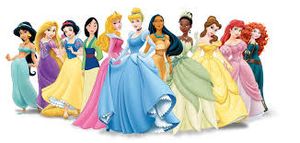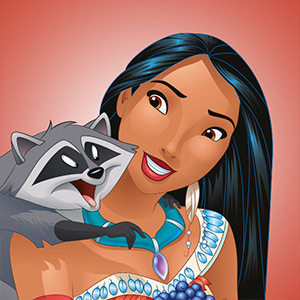GRSJ224/Indigenous Representation In Society
What is your fondest childhood memory? For myself, that memory includes watching Disney movies, particularly Cinderella with my family. However, it was not until after I arrived at university that I had noticed how completely blind I was to the portrayal of women through older Disney movies. Disney was reinforcing traditional gender roles through their movies, supporting the submissive women and the dominant man. Again, that is not the only problem with the Disney Princesses. What is wrong with this picture of the Disney Princesses?

I would say that there is a real lack of representation when it comes to Indigenous people. Some are thinking: What about Pocahontas? The Disney Movie Pocahontas (1995) is not remotely accurate of Indigenous people. If Indigenous people are not represented at all, then what does that say about their possible leadership presence in our society? I argue that because Disney movies are not representative of Indigenous culture, and appearance that children are raised with no understanding of respect or knowledge for Indigenous people, and that reinforces society to continue allowing the mistreatment of Indigenous people.
To begin, I would like to address the shortage of Indigenous culture present in our society. Indigenous people are seemingly missing from being represented in children’s movies. The article Cultural Representations in Walt Disney Films: Implications for Social Work Education by Katherine van Wormer and Cindy Juby (2016) analyzes Disney films including The Lion King, Pocahontas, and The Princess and the Frog (pp. 578). These movies were selected because they all deal with multicultural themes (Wormer et al. 2016, pp. 578). I will only discuss the Pocahontas film, as I am focusing on Indigeneity. Wormer et al. (2016) focuses on the above Disney movies in relation to “race, sex, ethnicity, and consumerism” (pp. 578). Wormer et al. (2016) reviews Pocahontas to “embrace[s] a Western perspective on individual destiny” (pp. 587). I believe this to be a further white washing of the real historical Pocahontas that Disney’s movie was based on. Changing factual representations to westernize an Indigenous figure can relate to the misrepresentation that is currently being advertised to our society. Wormer et al. (2016) found that Disney movies, even the newer ones contain concealed messages that include disrespectful views of particular races (pp. 591). Wormer et al. (2016) also noted that these insults as they write, are note always attentively aware to the viewer (pp. 591). For example, the Disney film Pocahontas (1995) has a song entitled Savages that plays into the stereotype of Indigenous people being uncivilized and they need the colonizers help to become less savage. This is an awful representation of Indigenous people that is not accurate and only reinforces the view that Indigenous people are others in our society.
Furthermore, since Indigeneity is not represented, young women can be seen to grow up thinking of only one certain appearance is acceptable in society. These reinforced gender roles are not representative of Indigenous women at all, which seems to show that our society does not value their presence. With a lack of representation in our society the Indigenous appearance is not seemingly viewed as an acceptable beauty standard in our society. The article Damsels in Discourse: Girls Consuming and Producing Identity Texts Through Disney Princess Play by Karen E. Wohlwend (2009) explains how children are conquered through popular narratives that are found in the media (pp. 57). These narratives seem to dictate how young girls grow up idealizing certain appearance over others. Wohlwend (2009) inspects how gendered narratives are connected to films and associated toys (pp. 57). Wohlwend (2009) found that while the young girls were engaging in playtime gender tensions arose (pp. 63). I believe this helps cement that because traditional gender roles are shown in popular children films, such as Disney, children are socialized and recreating the roles themselves, which further creates the cycle of gender division. How we are socialized, even before birth, and as children in this case through movies, and interacting with other children and toys creates future preferences. Likewise, recent Disney movies have no accurate Indigenous influence. Past movies, such as Pocahontas (1995) does not represent the true colonization and the consequences faced by Indigenous people. So how are Indigenous representations portrayed to young girls if at all? Is this the ideal Indigenous beauty standard set by our society? (https://www.google.ca/search?q=pocahontas&source=lnms&tbm=isch&sa=X&ved=0ahUKEwiytdyGg9HVAhWrwlQKHXjUCvMQ_AUICigB&biw=1280&bih=659#imgrc=RbHJ7xYWF3OMOM)

Lastly, the misrepresentation Indigenous people face seemingly contributes to further marginalization. For example, the families of the missing and murdered Aboriginal women have yet to see justice. Indigenous women are going missing and found murdered; most of them on know the named ‘Highway of Tears’. The article Newsworthy Victims? Exploring Differences in Canadian Local Press Coverage of Missing/Murdered Aboriginal and White Women by Kristen Gilchrist (2010) shows how differently missing Aboriginal women are displayed in the media, compared to white women (pp. 373). Gilchrist (2010) found that Aboriginal women were given smaller font sizes, pictures (if any) and a little amount of coverage (pp. 379). Also, white women were more humanized, relating to their family left behind (Gilchrist 2010, pp. 382). I chose this article to articulate the importance of Indigenous people being misrepresented in the media, as they are not being given equal exposure. Additionally, the article Missing and Murdered Women: Reproducing Marginality in News Discourse by Yasmin Jiwani and Mary Lynn Young (2006) discuss how missing Aboriginal women are continuously being written in stereotypes of being sex workers, to lesser the seriousness of what is occurring (pp. 895). Jiwani et al. (2006) found that these women are facing a gendered crime, and there is no enforcement of further investigations into the cases because of the marginalization of their representation (pp. 901). This article helps analyze how society reacts to the consequences Indigenous people are facing.
As for what future research could implement to expose Indigenous culture onto children earlier is proposed by Barbara McNeil (2012). McNeil’s article A Case For Using Indigenous Children’s Literature For Emotion Socialization in Schools suggests that Indigenous culturally relevant picture books be used in allowing children to learn (pp. 97). McNeil (2012) states that this could possibly help dilute the conflict Indigenous people face with exclusion and the devaluing of their people (pp. 97). I believe this would be a good start to try and bring children a source that is not misrepresenting the Indigenous culture. As mentioned above, our society portrays Indigenous people as reoccurring stereotypes and this could help balance that absence of representation at a young age.
I also found a secondary source website article entitled 5 Classic Disney Movies the Reinforce Gender Roles (2016) by Brittany McNaney where she discusses Beauty and the Beast, Cinderella, The Little Mermaid, Sleeping Beauty, and Snow White and the Seven Dwarfs. This is relevant to my topic because of how influential these movies are to young women, which can reproduce certain roles that they will portray in their future. Another secondary source website article is entitled 5 Common Native American Stereotypes in Film and Television by Nadra Kareem Nittle (2017). Nittle (2017) looks are the typical portrays of Indigenous people in both film and television, such as the bloodthirsty warrior. This is important to note because if Indigenous people are only being shown a certain way, individuals assumptions about them will not change. I have provided the two links below for your curiosity. 1. https://www.theodysseyonline.com/reinforcing-gender-roles 2. https://www.thoughtco.com/native-american-stereotypes-in-film-television-2834655
Reference
Disney’s Pocahontas. 1995.
Gilchrist, K. (2010). Newsworthy Victims? Exploring Differences in Canadian Local Press Coverage of Missing/Murdered Aboriginal and White Women. Feminist Media Studies, 10(4), 373-390. doi: 10.1080/14680777.2010.514110
Jiwani, Y., & Young, M. L. (2006). Missing and Murdered Women: Reproducing Marginality in News Discourse. Canadian Journal of Communication, 31(4), 895-917. Retrieved from http://ezproxy.library.ubc.ca/login?url=https://search-proquest-com.ezproxy.library.ubc.ca/docview/219564084?accountid=14656
McNaney, B. (2016). 5 Classic Disney Movies That Reinforce Gender Roles. Odyssey. Retrieved from https://www.theodysseyonline.com/reinforcing-gender-roles
McNeil, B. (2012). A Case For Using Indigenous Children’s Literature For Emotion Socialization in Schools. Global Studies of Childhood, 2(2), 97-105. Retrieved from www.wwwords.co.uk/GSCH
Nittle, N. K. (2017). 5 Common Native American Stereotypes in Film and Television. Though Co. Retrieved from https://www.thoughtco.com/native-american-stereotypes-in-film-television-2834655
Wohlwend, K. E. (2009). Damsels in Discourse: Girls Consuming and Producing Identity Texts Through Disney Princess Play. Reading Research Quarterly, 44(1), 57-83. Retrieved from http://www.jstor.org/stable/20304573
Wormer, K., & Juby, C. (2016). Cultural Representations in Walt Disney Films: Implications for Social Work Education. Journal of Social Work, 16(5), 578-594. doi: 10.1177/1468017315583173